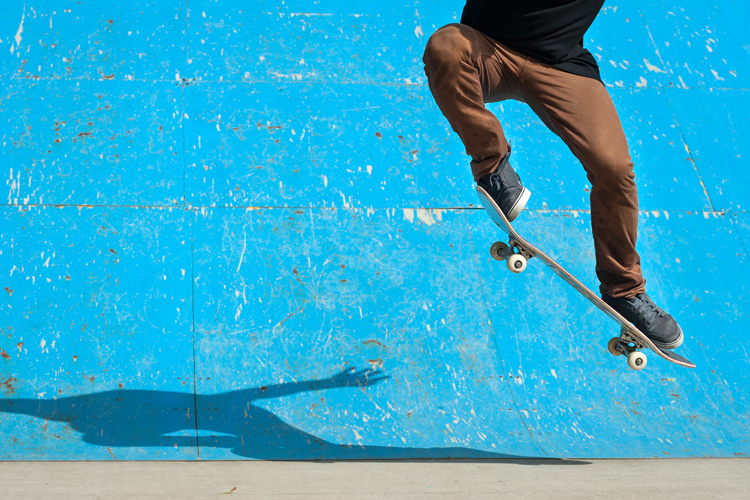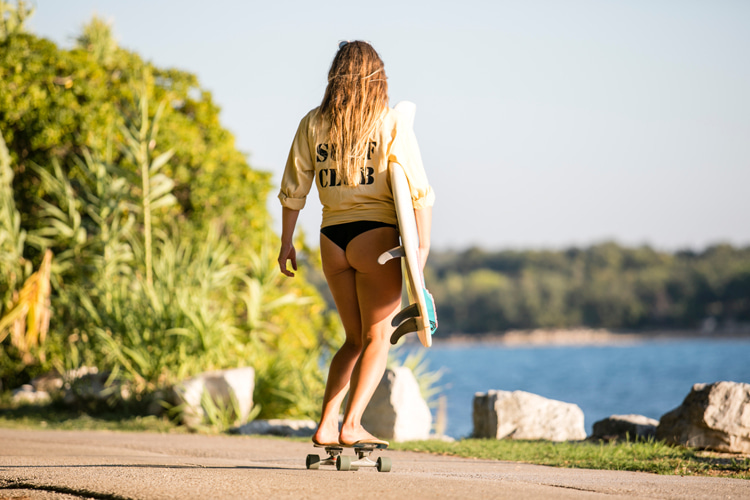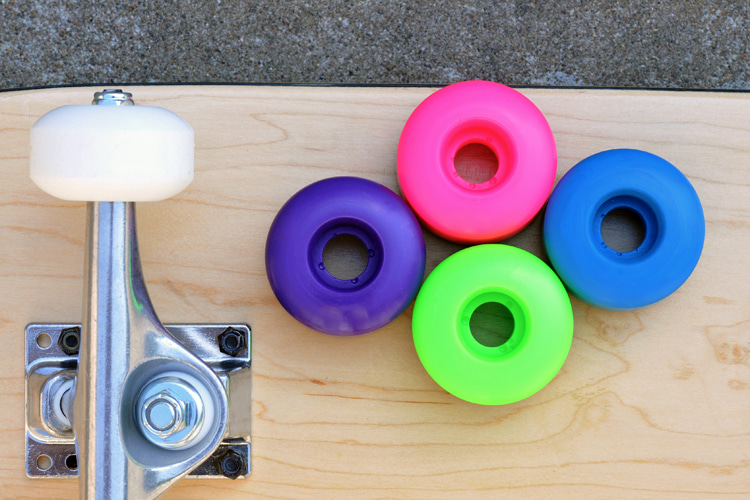Hardness plays a major role in the performance of skateboard wheels. Here's everything you need to know about the durometer scale.
When it's time to choose a new set of urethane wheels, there are two variables that must be addressed and taken into consideration - size and hardness.
Most wheels have both the size and the hardness printed somewhere on the wheel graphic.
So, what exactly is the skateboard wheel hardness - or durometer - scale?
It is a chart - or ranking system - that measures the level of grip a skateboard wheel has and the impact and amount of shock it can absorb.
The majority of wheel manufacturers use the Durometer A Scale, which means the hardness level often has an "A" next to it.
Other manufacturers use the Durometer B Scale, which measures 20 points below the Durometer A Scale.
As a result, it allows for an additional 20 points for the hardest wheels.
In skateboarding, and according to the Durometer A Scale, the wheel's hardness is measured in durometers and ranges from 75A (softest) to 101A (hardest).
A very soft skateboard wheel offers high grip and maximum comfort and provides a smooth ride. Nevertheless, it wears fast and is extremely slow.
A very hard skateboard wheel is extremely fast, highly reactive, and wears slowly. However, it has a poor grip and vibrates with the slightest impact.
Let's take a closer look at the main skateboard wheel hardness scale levels.

75A-87A Skateboard Wheels
These are extremely soft wheels. They were designed to be used with longboards or with standard skateboards rolling over rough surfaces.
They have a lot of grip and will absorb the impact of bumpy streets and roads and cracks in the pavement.
75A wheels deliver the smoothest ride, and they're the go-to setup for cruising, commuting, and downhill skateboarding.
88A-95A Skateboard Wheels
These are slightly harder and faster wheels. Although they provide less grip, they're still soft enough to cruise over bumps.
It's an intermediate setup for street skaters who seek a comfortable ride in an urban context.
96A-99A Skateboard Wheels
These are a fairly balanced set of wheels that will adapt to street skating, skatepark riding, bowls, ramps, and nearly all smooth surfaces.
The setup is often used by beginners because it provides good grip and moderate speed characteristics.
It is an all-around skateboard wheel that will not compromise on bumpy or plain concrete surfaces.
100A+ Skateboard Wheels
These are the fastest and hardest wheels you can have on a skateboard.
They have the least amount of grip and are not suited for riding rough and slick surfaces.
Professional skateboarders tend to use them in competitions, indoor skateparks, and high-end surfaces specifically designed for sidewalk surfing.
It's the weapon of choice in technical and park skateboarding.

Soft versus Hard Wheels: Which Ones Should You Get?
Choosing the right hardness wheels can be complicated for beginner skaters.
It's one of those decisions that has a lot to do with skill level, skateboarding style preferences, and riding conditions.
But, in the end, it's all about adapting your wheel selection to the average surface conditions you're going to ride on.
A softer wheel such as a 92A or 94A will be smoother over rough terrain, provide more contact area with the ground and more grip.
Soft wheels compress when pressure is applied, and so they will cushion even the slightest impact. But they're also slower.
On the other hand, a 100A plus wheel is very fast, but you will feel every bump and crack on rough terrain.
Its footprint is smaller and provides less traction, but because it has less friction, you'll experience less drag on smooth surfaces and, therefore, a faster ride and increased responsiveness.
With hard wheels, you'll feel every pebble on the pavement, and the board will respond immediately to your body movement.
It is easier to perform an ollie on hard wheels than on soft wheels; it is more comfortable to ride on the tarmac with soft wheels than with hard wheels.
If you are unsure where to begin, 97A provides a good balance between grip and speed and is always an excellent set to start with.
However, especially if you're an intermediate or advanced skater, you'll need to know where you'll be using your wheels and what you expect to do to get the most out of them.
As a general rule of thumb, if you spend most of the time at a concrete skatepark, harder wheels will provide plenty of grip and speed.
If you're skating on sidewalks and asphalt parking lots, then softer wheels will help absorb the roughness of the surface and produce a smoother ride and more grip.
They're also the best wheel hardness pick for bombing hills and cruising around town.

The Durometer B Scale
As stated above, some skate companies saw a need for wheels that are even harder than 100A, so they created the Durometer B Scale.
Durometer B Scale wheels are extremely hard, so the B rating scale starts where the A scale stops.
The conversion from the A to B Durometer Scale is as follows:
- 100A = 80B
- 101A = 81B
- 102A = 82B
- 103A = 83B
- 104A = 84B
